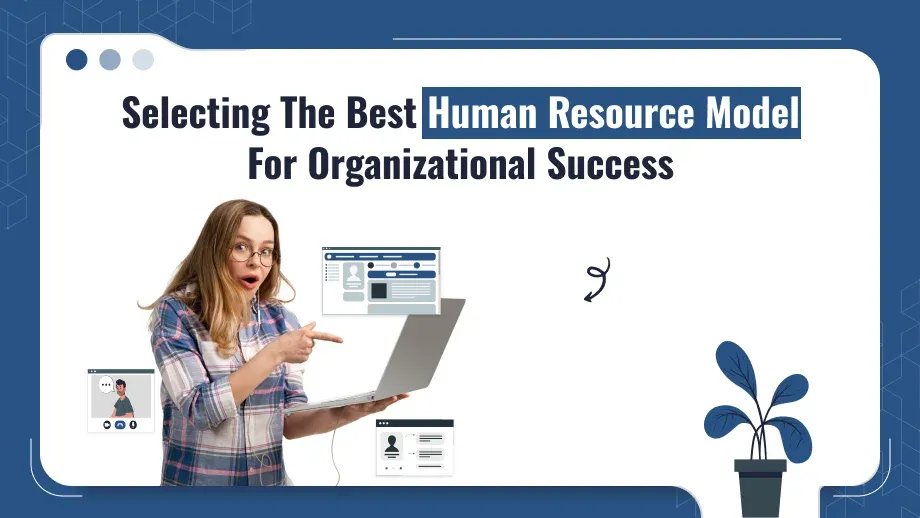
Introduction: Why Human Resource Models Matter
A human resources model is a strategic roadmap for directing the corporation’s HR practices toward business objectives. Models in human resources are crucial because they give an outline of effective workforce management. They help guide policies and initiatives that the HRM undertakes. Today, in the hyper-complex business environment, a robust human resources model can make everything, from talent acquisition to employee engagement, organizational culture, and productivity, all take place optimally.
Choosing the proper model is a key decision for the HR leader and the business executive as it directly impacts workforce performance, organizational culture, and the direction of a firm. This article will go in-depth into a popular human resource planning model as well as insights into selecting and implementing a framework best suited for your organization’s needs. From the Harvard Model to the 5 Ps Model, we would discuss which way such models help a person to achieve sustainable growth with effective HR strategies in line with the overall business objectives.
What is a Human Resource Model?
A human resource model is a general concept that articulates the organizing framework for the conducting of functions in HR models as supporting the strategic objectives of a firm. Such models guide an organization’s approach to recruiting, training, managing, and retaining employees. In general, workforce development models support the workforce and offer a framework for HR practices toward helping an organization succeed.
Each HR framework serves different organizational needs. Some focus on ensuring the satisfaction of employees, while others target aspects like productivity, performance, or adaptability to change. A suitable human resource model can result in numerous benefits improvement of employee morale to streamlined operations and support for the long-term goals of the business.
Overview of Key HRM Models
Let’s look at five influential models of human resource management, each offering unique strategies for managing the workforce:
The Harvard Model
The Harvard Model considers the HR approach to be employee-centric, about participation and valuing employees as important stakeholders. This model focuses on employee well-being along with engagement and advocates the use of HR policies that are a balanced solution between employee and organizational interests.
- Core elements: Employee participation, work systems, reward structures.
- Advantages: Higher employee engagement and loyalty help it to engage with an inclusive workplace culture.
- Best suited for: Organizations seeking a democratic approach to decision-making with an eye on employee satisfaction.
This model is very helpful for organizations that are committed to the establishment of a friendly working environment. It allows HR Skills to build a culture of mutual respect, where employees feel they play a role in shaping the organization.
The Guest Model
The Guest Model is more strategic in that it aligns HRM practices with business outcomes. It focuses on six elements: HRM strategy, HRM practices, HRM outcomes, behavioral outcomes, performance outcomes, and financial outcomes. The Guest Model establishes a high-performance culture by ensuring human resource model activities are linked with organizational results.
- Core elements: Strategic alignment of HR practices, focus on measurable outcomes.
- Benefits: Boosts employee commitment, enhances productivity, and supports business goals.
- Best fit for: Organizations that are performance-driven and looking to link HR practices to tangible results.
With its focus on performance and metrics, the Guest Model is ideal for organizations that prioritize measurable Human Resource Specialist. By aligning HR strategy with business goals, it fosters a results-oriented culture where HR practices directly contribute to company growth.
The Warwick Model
This Warwick Model is sensitive to the internal and external environment of the organization, and its flexibility enables it to adapt in sensitive ways. It was developed by Hendry and Pettigrew. According to this model, HRM strategies have to be flexible in responding to change in the business environment. There are two major elements involved in this model: inner and outer contexts (organization structure, culture, and external factors) and HRM content (HR policies and practices).
- Core elements: Context-based approach, adaptable HR strategies.
- Benefits: Tailors HR practices to fit both organizational and market demands.
- Best fit for: Companies operating in dynamic or volatile environments that require flexible HR strategies.
This is a very effective model for organizations operating in dynamic industries, as it’s flexible. The Warwick Model allows an organization to be responsive to external changes while having pertinent and feasible HR practices that remain.
Boost efficiency with Superworks HRMS – reduce HR workload by 80%!
Transform your human resource model from manual to automated in just a few steps.
The Ulrich Model
The Ulrich Model categorizes HR into four roles: strategic partner, administrative expert, employee champion, and change agent. This structure helps organizations balance strategic initiatives with everyday HR functions.
- Core elements: Defined HR roles, balance of strategic and operational functions.
- Benefits: Provides a structured approach to managing both administrative tasks and strategic goals.
- Best fit for: Organizations seeking clarity in HR roles and a mix of strategic and operational focus.
The Ulrich Model is ideal for organizations that require a clear distinction between operational and strategic HR functions. It helps Human Resource Policies allocate resources effectively and supports a structured approach to talent management and organizational change.
The 5 Ps Model
The 5 Ps Model (Philosophy, Policies, Programs, Practices, and Processes) aligns HR practices with the company’s philosophy. The model focuses on creating a solid cultural base by aligning the Human Resource model with the vision and mission of the organization.
- Core elements: Focus on philosophy, value-based approach to HR.
- Benefits: Aligns the organizational values with the initiatives that the HR drives.
- Best for: Companies seeking to align the organizational culture to their overall culture through HR practices that reflect the core values of the organizations.
The 5 Ps Model thrives in value-driven organizations. This model grinds HR activities on the philosophy of the company. It thus aids in a cohesive culture and strengthens the connection between HR practices and organizational goals.
Choosing an HR Model for Your Organization
Choosing the appropriate human resource model for your organization requires careful consideration of several factors. Here is a step-by-step approach to help you make the right choice:
- Evaluate Your Business Goals: Begin by finding out what are primary goals for your organization are. For example, if your goal is to create a high-engagement culture, then a people-centered model such as the Harvard Model would be ideal. Alternatively, if performance is your focus, the Guest Model could align HR in India with measurable business outcomes.
- Understand the Culture of Your Company: Determine whether your company’s culture is more hierarchical or collaborative. A traditional organization may be appropriately structured with the Ulrich Model. However, a more value-driven company should focus on an approach like the 5 Ps that will best fit its culture and philosophy.
- Asses HR Capacity and Resources: Assess your current capabilities of your HR team. For small HR teams with fewer resources, a simplified model might be easier to apply. However, larger organizations with robust HR departments may benefit from the Ulrich Model, which clearly defines HR software India.
- Consider Industry Demands: Your industry may also influence your choice. For example, companies in fast-paced industries may need the flexibility of the Warwick Model to adjust HR practices to changing market conditions.
- Analyze Workforce Needs: Determine what your employees need most. If employee well-being and participation are priorities, the Harvard Model may be the best fit. For a focus on high commitment and productivity, the Guest Model is a strong contender.
Implementing Your Chosen HR Model
Once you’ve selected an HR model, implementing it effectively is the next step. Here are the core elements of a successful implementation process:
-
Define Objectives and Metrics:
Clarify what you want to achieve. Metrics would include employee engagement, productivity, and turnover rates, depending upon the model chosen.
-
Align the Model with Culture:
Ensure the chosen model fits well with the company’s values and work culture. Models like the 5 Ps Model, which focuses on philosophy, will require HR practices that are well-integrated with company values.
Implementation can only occur if all levels of the organization buy into the change. Host meetings and have tools and resources to enable the employees about how the new HR model benefits them.
Equip your HR professionals with the tools and training necessary to execute the model effectively. Familiarity with key HR terminology and model-specific skills will be crucial.
Track the impact of the model over time. Regular assessments allow you to refine the model as necessary, ensuring it continues to meet organizational needs.
Selecting the Right Human Resource Development Models
Several factors determine the suitable human resource development models:
- Organizational Goals: Determine whether the primary objective of your organization is to enhance skill performance, foster adaptability, promote a culture of continuous learning, or leadership development.
- Employee Requirements: Assess the needs of your employees to develop. If your employees require practical experience, then the 70-20-10 Model might be suited for them. To measure and enhance the upgrading of skills, the Kirkpatrick Model will be ideal.
- Available Resources: Consider the budget and resources your organization can allocate. Models like ADDIE, which involve formal training, may require more investment, while experiential learning models are often cost-effective.
- Learning Culture: Choose a model that aligns with your organizational culture. Companies in India that prioritize real-time learning might favor the Action Learning Model, while those using HRMS Payroll Software in India may prefer structured approaches like analyzing, designing, Developing, Implementing, and Evaluating.
For organizations seeking resources, an HR can offer valuable tools and information to support model implementation. Additionally, using HR Competencies effectively is crucial in building a successful HRD strategy.
Conclusion
Selecting and implementing the right human resource model can greatly impact your organization’s growth and employee engagement. Each model, whether it’s the strategic Ulrich Model, adaptable Warwick Model, or value-based 5 Ps Model, offers distinct benefits. By choosing a model that aligns with your organization’s goals, culture, and workforce needs, you create an HR framework that supports sustainable success.
For further insights into strategic HRM, HR models, and competencies, check out our HR Portal for resources to build a strong HR foundation that aligns with your organization’s values and objectives.





